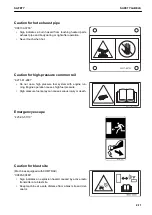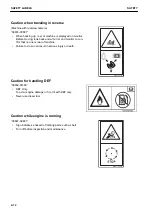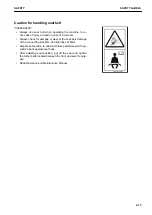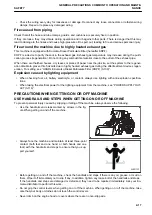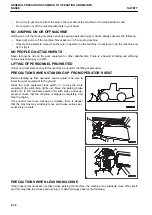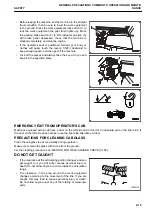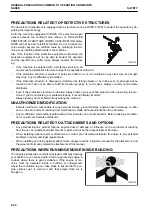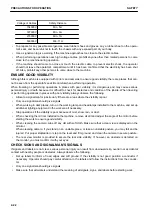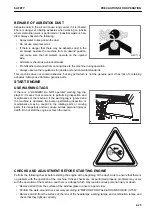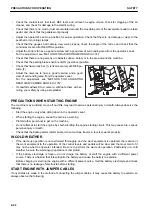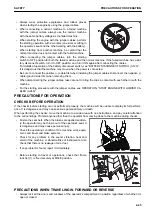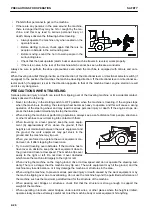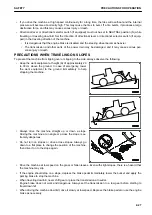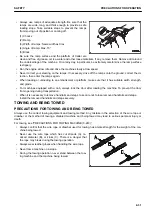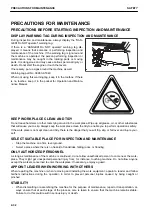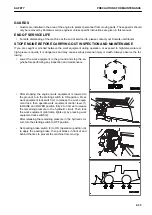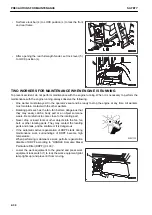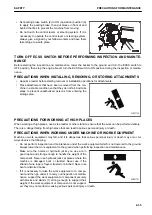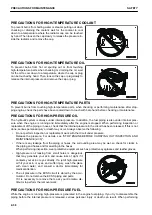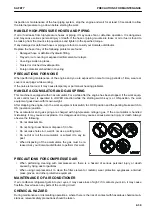
• Always wear protective eyeglasses and rubber gloves
when starting the engine by using the jumper cables.
• When connecting a normal machine to a failed machine
with the jumper cables, always use the normal machine
with the same battery voltage as the failed machine.
• When starting the engine with the jumper cables, perform
the starting operation with 2 workers (one worker sitting in
the operator's seat and the other working with the battery).
• When starting from another machine, be careful that the
normal machine does not contact with the failed machine.
• When connecting the jumper cables, turn the starting
switch to OFF position for both the failed machine and the normal machine. If the failed machine has a bat-
tery disconnect switch, turn it to OFF position, and turn it ON again after connecting the cables.
For details of operation of the battery disconnect switch, see “BATTERY DISCONNECT SWITCH (3-123)”.
It is dangerous that the machine may move when the power is connected.
• Be sure to connect the positive (+) cable first when installing the jumper cables. Disconnect the negative (-)
cable (ground side) first when removing them.
• When disconnecting the jumper cables, take care not to bring the clips in contact with each other or with the
machine.
• For the starting procedure with the jumper cables, see OPERATION, “START ENGINE WITH JUMPER CA-
PRECAUTIONS FOR OPERATION
CHECKS BEFORE OPERATION
If the checks before starting are not performed properly, the machine will be unable to display its full perform-
ance. It is dangerous and may cause serious personal injury or death.
When performing the checks, move the machine to a wide area with no obstructions, and pay careful attention
to the surroundings. Prohibit anyone other than the operator from coming close to the machine during checks.
• Fasten the seat belt. When the brakes are applied sudden-
ly, the operator may be thrown out of the operator's seat. It
is dangerous and may cause personal injury.
• Check the operating condition of the machine, work equip-
ment, and travel and brake systems.
• Check for any problem in the sound, vibration, heat and
smell of the machine, or abnormalities of instruments. Also
check that there is no leakage of oil or fuel.
• If any problem is found, repair it immediately.
• Before starting to travel or operations, check that frame
lock bar (1) is fixed securely at FREE position.
PRECAUTIONS WHEN TRAVELING IN FORWARD OR REVERSE
• Always lock all the doors and windows of the operator's compartment in position regardless of whether it is
open or closed.
SAFETY
PRECAUTIONS FOR OPERATION
2-25
Summary of Contents for WA480-8
Page 2: ......
Page 19: ...Distributor name Address Phone Fax Service personnel FOREWORD PRODUCT INFORMATION 1 17...
Page 29: ...LOCATION OF SAFETY LABELS SAFETY SAFETY LABELS 2 3...
Page 159: ...SWITCHES 1 ECSS switch 2 Front working lamp switch OPERATION EXPLANATION OF COMPONENTS 3 91...
Page 302: ...Securing position Fixing angle A 61 B 53 C 33 D 38 TRANSPORTATION OPERATION 3 234...
Page 324: ......
Page 397: ...Viewed from the rear side of the machine MAINTENANCE MAINTENANCE PROCEDURE 4 73...
Page 402: ......
Page 403: ...SPECIFICATIONS 5 1...
Page 406: ......
Page 422: ......
Page 423: ...REPLACEMENT PARTS 7 1...
Page 439: ......

